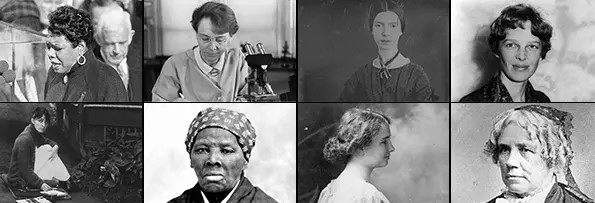Women’s history today is no longer a backwater, nor is the profession of history a male craft.
-
November/December 2004
Volume55Issue6

It is trivializing women’s history to suggest that baby has come a long way in the last 50 years. Women have always considered their past, often through genealogies, storytelling, oral histories, and even quilts. But in the last half-century women’s history in books and articles has come of age.
Today it is still mostly women who are its chroniclers. Most men avoid women’s history. This is not necessarily a bad thing, but it does suggest the degree to which symmetry—true equality of an androgynous fellowship—continues to elude us in everything from housework to the writing of history. To a much greater extent than in the field of black history, which whites do not hesitate to enter, women’s history remains largely a gender-segregated preserve, what Charlotte Perkins Gilman once designated as Herland.
A previous generation of determined pioneers of “herstory” deserves credit for the emergence of women’s history as a legitimate subject. Their fundamental insight, encouraged by the feminism of the 1960s and 1970s, was that the personal was the political. Along the way the field has changed the mainstream understanding of what a proper study of the past must include.
In the case that women historians have explicitly made, if history is to offer a context for both present and future, it must not simply be a consideration of public events and male leaders. A paraphrase of Alexander Pope serves as an appropriate slogan for the social history that women historians have taught their compatriots: “How small a part of all mankind endures/That part that laws and leaders can cause or cure.” To ignore women in history is to misunderstand the entire organization of any society.
Accordingly, the women’s history of today has spawned new historical study of topics such as family history, reproduction, sexuality, marriage, and courtship as well as investigations of institutions and politics. No longer simply an exercise in filling in the shadows and giving compensatory time to women worthies or noting their contributions, the field has established a new tapestry for all historians to embroider. And it is often ordinary folk who become its subject matter, whether anonymous members of the suffrage movement or textile workers in the early-twentieth-century South.
Today women’s history is no longer a backwater, nor is the profession of history a male craft. On the contrary, the field has developed its own structures. These include collections of primary sources available through the Internet, meetings of historians at the Berkshire Conference on the History of Women, journals, and even controversies, such as that over the relation between private and public spheres, or over the issue of mainstreaming—whether it is time to end the separate focus on women’s history. (The eminent historian Gerda Lerner recently commented that men had had 4,000 years to define history by looking at the activities of other men. “Give us another 4,000 years and we’ll talk about mainstreaming.”)
Some books stand out as pioneering studies in the creation of American women’s history—as essential texts, because they established and defined the perimeters of the subject. Others are noteworthy as especially fine examples of the practice of women’s history. What follows is my list of the classics in the field that should not just be on everyone’s bookshelf but should be savored and enjoyed.
In 1953 the translated version of the French existentialist Simone de Beauvoir’s
Soon a number of professionally trained scholars began investigating that history, some (and I am one) having been influenced by a second classic, Betty Friedan’s 1963
While both Friedan and Beauvoir adopted the oppression model of women in history, Mary Ritter Beard thought differently. In 1946 she published
No matter which approach women historians took, they needed conceptual frameworks if they were to progress beyond mere description. Gerda Lerner provided these early road maps in her 1979 series of essays
For these pioneers in women’s history, the essav proved a compatible medium. In 1985 another talented historian, Carroll Smith-Rosenberg, used it in
Another trailblazing contribution to women’s history, Linda Gordon’s
By the 1980s there were several textbooks of women’s history, including Mary P. Ryan’s ambitious
Paula Giddings’s
The sources for historians of women are fewer and more challenging than those for historians of men. But in her elegant unraveling of the previously neglected diary of an eighteenth-century midwife, Laurel Thatcher Ulrich shows how the simple entries of Martha Ballard can become the historical means of entering the life of a community.
While many historians focus on women’s culture and organizations, others—including Linda Kerber, Ann Firor Scott, and Ellen DuBois—concentrate on women’s efforts to end the political discrimination against them and achieve true citizenship in the United States. Essential to their work is the painstaking editing of the papers of the nineteenth-century suffrage leaders Susan B. Anthony and Elizabeth Cady Stanton by Ann B. Gordon, titled

